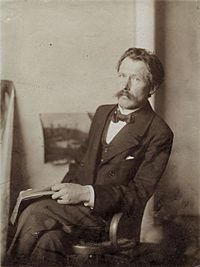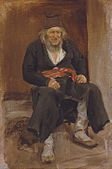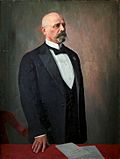Paul Raud facts for kids
Quick facts for kids
Paul Raud
|
|
|---|---|

Paul Raud, c. 1910
|
|
| Born | October 22, 1865 Kirikuküla, present-day Estonia
|
| Died | November 22, 1930 (aged 65) |
| Nationality | Estonian |
| Movement | Realism, Impressionism |
Paul Raud (born October 22, 1865, died November 22, 1930) was an important Estonian painter. He was born in a place called Kirikuküla, which is in Estonia today. He later passed away in Tallinn, the capital city of Estonia.
Early Life and Art School
Paul Raud had a twin brother named Kristjan Raud, who was also a famous painter. Paul started studying art in 1886. He went to a special art school called the Kunstakademie Düsseldorf in Germany.
While he was there, he was greatly inspired by the paintings of Eduard von Gebhardt. Paul Raud became part of a group of artists known as the Düsseldorf School of painting. This school had a special way of painting that many artists followed.
Painting and Travels
After finishing his studies, Paul Raud returned to Estonia. For a while, he mainly painted portraits for people who asked him to. These were special paintings of individuals.
In 1896, he went on a trip with his brother Kristjan and another artist named Amandus Adamson. They visited the beautiful Estonian islands of Muhu and Pakri. These trips often inspired artists to create new works.
Teaching Art
Later in his life, especially during and after World War I, Paul Raud started teaching art. In 1915, he became a drawing teacher at the Tallinn Institute of Commerce. This was a school where people learned about business.
From 1923, he taught at the State School of Industrial Art in Tallinn. He helped many young artists learn how to draw and paint. His teaching helped shape the next generation of Estonian artists.
Where to See His Art
Today, you can see many of Paul Raud's paintings in the Art Museum of Estonia. This museum is located in Tallinn and holds a large collection of Estonian art.
Gallery
-
Jaan Poska portrait (1929)










